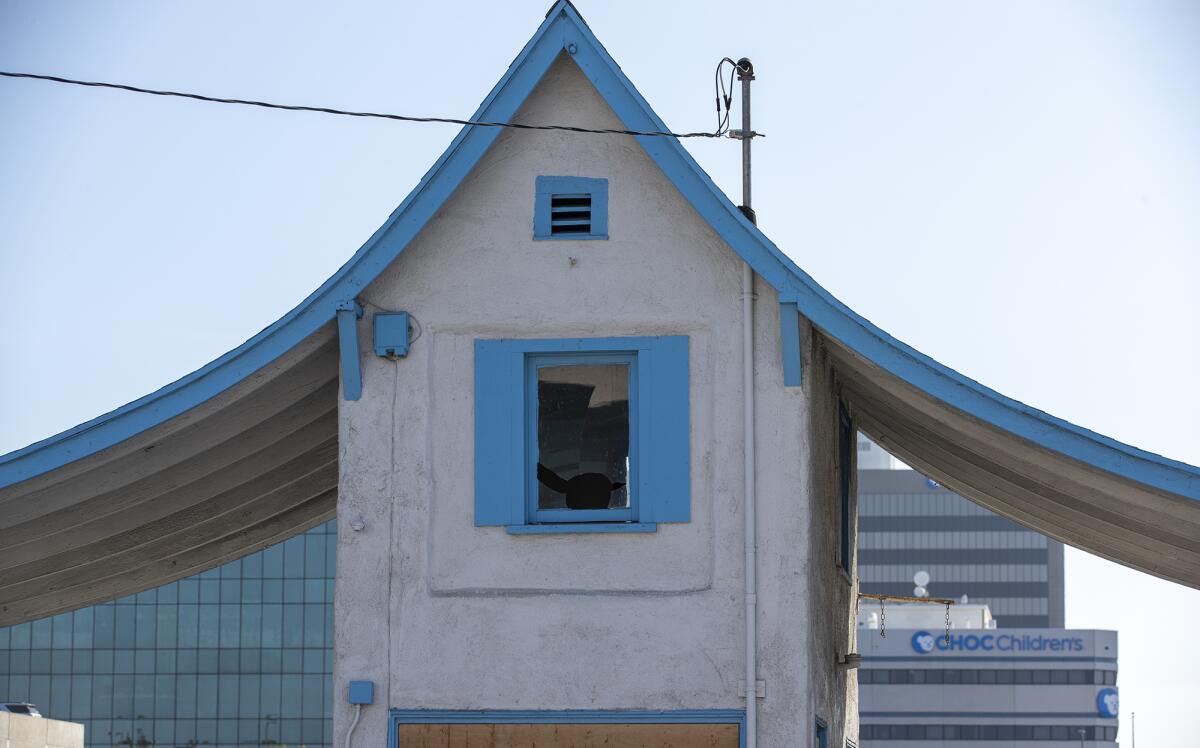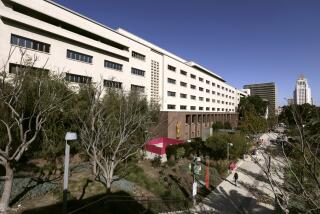Historic gas station in Orange stays put after development dispute

- Share via
A small storybook-style building on an Orange street corner has seen better days. Its windows are boarded up. Patches of grass and weeds sprout from broken concrete. And the grounds have been dormant for years since it last saw business as a flower shop.
Still, the slim, two-story edifice’s blue-trimmed, steep-sloped and curved roofs remain whimsical enough to attract curious looks from commuters on Main Street.
Nearly a century ago, the former gas station would have invited now-classic cars to pull up to fuel pumps off what was once was a stretch of Highway 101, an arterial road connecting Los Angeles to San Diego through Orange County.
That the longtime gas station, which first opened for business around 1928, is historic and charming is no haggle. But property owners and preservationists have competing visions over its future — and how it gets there.
For Krista Nicholds, executive director of Preserve Orange County, the gas station is one of four local historic sites on the nonprofit’s “endangered” list. Property owners had eyed moving the building over to an empty plot on Glassell Street, which they also own, to clear the way for development on Main.
But Nicholds’ group first responded when learning of the Northern Gateway project earlier this year; original plans for the proposed retail center on Glassell included moving the gas station there.
“With this little building, there was so much interest from the community at large,” she said. “We also felt that we were seeing a trend in Orange, which traditionally has been stalwart with respect to the protection of historic resources. Taking a stand was important in this case for those reasons.”
In November 2020, a cultural resources assessment sponsored by the property owners deemed the site ineligible for the National Register of Historic Places on the grounds of significant alterations to it, a conclusion at odds with prior evaluations dating back to 1982.
“We didn’t want it put on the register so that we could move the building,” said Leason Pomeroy III, co-owner of the property. As part of the Northern Gateway project, Pomeroy envisioned the gas station serving as a “statement building” leading into Old Towne Orange.
Nicholds contends that while Preserve Orange County isn’t opposed to moving the gas station, doing so while deeming it ineligible to be listed on the register would be inappropriate and opens up a process that threatens the diminutive building with irreparable alterations, ones that could truly disqualify it.
“It needs a proper study to support the move,” she said. “It needs to follow the correct guideline. Once it’s moved, it needs to be orientated in a way that maintains, as best possible, its historic orientation. Those were things that were ignored.”

In March, Pomeroy withdrew the Northern Gateway project’s application with the city after the Design Review Committee recommended denying the project, but Preserve Orange County pressed onward with its efforts.
Since the gas station isn’t within Orange’s historic Old Towne or Plaza districts, the only recourse, as the group saw it, lay with the register. After teaming up with the Old Towne Preservation Assn., Preserve Orange County raised funds in order to hire a consulting firm to make the official case.
The 32-page application traces the history of the gas station back to two entrepreneurs, Fritz Johan Christiansen, a Danish immigrant, and Carl Emerson Grow. They established the business at a time when cars became more affordable. By 1929, more than 143,000 gas stations dotted the nation while, according to Department of Energy data, the average cost for a gallon of gas was 21 cents.
Christiansen and Grow bowed out of the business by the 1930s. Another proprietor, Donald Clark, turned the site into a Mobil station from 1952 until a dispute with the oil corporation in 1988 ended operations.
According to the application, the largely intact building is an “exceptionally rare example of a pre-1930s gas station in Southern California.” In fact, south of Santa Barbara only eight gas stations from that era remain. Aside from the one in Orange, there are three in Orange County, all in coastal cities.
After submitting the paperwork, a state historian recommended the gas station go before the California Historical Resources Commission. On Oct. 29, the commission unanimously nominated the station for the federal Register alongside other Orange County sites such as St. Isidore Catholic Church in Los Alamitos and Santa Ana’s Floral Park Historic District.
But it faces zero prospects of being listed due to the dispute with the property owners over the gas station’s eligibility.
“Because the owners objected to formal designation, the Keeper of the National Register actually can’t list it,” Nicholds said.
Despite that, if the gas station is determined eligible, which the register can formally do, the site will be added to the state’s Register of Historic Places, which would give it enough status under the California Environmental Quality Act to warrant more rigorous reviews of any plans to demolish or move it.

Earlier this year, Pomeroy resubmitted the Northern Gateway project without the gas station as part of its plans. Orange’s Planning Commission unanimously recommended it for approval during its Sept. 20 meeting. The project has yet to go before City Council, but Pomeroy is hoping that construction can begin before the end of the year.
For now, the gas station won’t be moved anywhere as it stands alone while the rest of the plot is fenced off for construction crews working on an adjacent parking garage. The property owners have leased it for such purposes.
“The owners of the building have said that they have no intentions of demolishing the building,” Nicholds said. “We have no reason to believe otherwise. However, we do think it’s still threatened.”
Pomeroy doesn’t see the gas station as endangered, only idle as the lease agreement for the land around it carries through next year.
“It’s just going to sit there for now,” he said.
More to Read
Sign up for Essential California
The most important California stories and recommendations in your inbox every morning.
You may occasionally receive promotional content from the Los Angeles Times.











